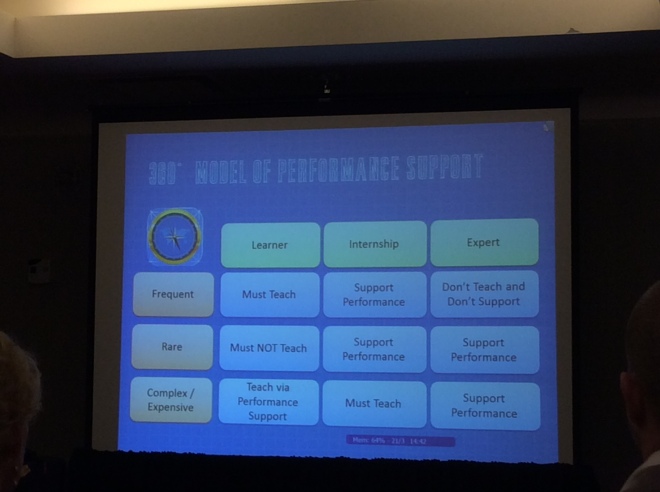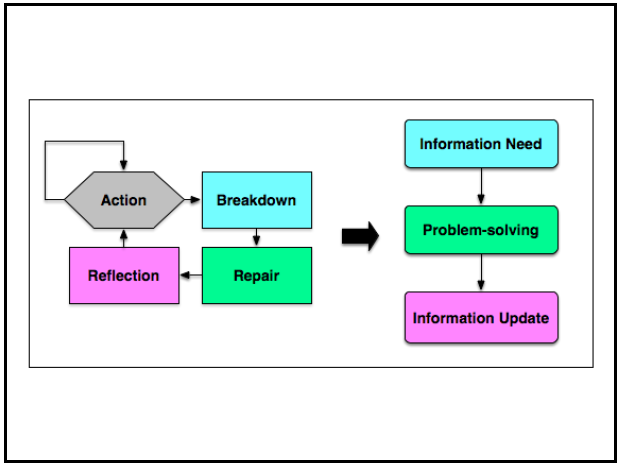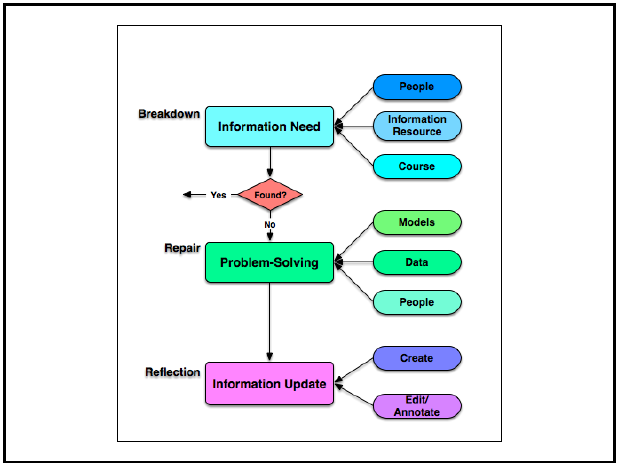LSCon Day 3 recap: Free resources, performance support, Quinn and Cathy Davidson
I have attended a number of sessions at day 3 of LSCon, here are my session reports.
Free elearning tools and resources
I attended the morning buzz session of Tracy Parish. She presented (and collected) free elearning resources. Images, tools et cetera. I will not give you an overview. She has an website where everything is listed a must see for everyone who is looking for free stuff. Great work Tracy.
Practical principles for developing an effective performance solution
Presentation by Hillik Harari and Yanay (I love names that are palindromes) Zaguri. Though their solution is limited to performance support (as in online help with applications) they had some interesting notices.
Performance support requires a different mindset than learning. Learning is about behavior change, performance support is about offering the right info at the right time so people can do their job. They presented briefly about a method they call the 360 model:
 Intersting is that Learner, internship and expert has great resemblance with what by Bob Mosher and Conrad Gottfredson presented yesterday. They call it train, transfer and sustain. I also like the very concrete 9 cells of the matrix. Good stuff.
Intersting is that Learner, internship and expert has great resemblance with what by Bob Mosher and Conrad Gottfredson presented yesterday. They call it train, transfer and sustain. I also like the very concrete 9 cells of the matrix. Good stuff.
They also explained their 8 principles, here they are:
- Do not interfere with performance
- Be user sensitive
- Have a call for action
- Just in time
- Content sensitive
- Reduce cognitive load
- Give user control
- Keep it simple
I do think that there are worse rules to live by.
Dragging learning into the 21st century Clark Quinn
Where I found that Clark and his fellows where a bit sour and frustrated when presenting their eLearning manifesto, Clark was at his best today. He painted a picture of where we should go with very concrete steps and overviews. and a ton of cool references to great and interesting books. You can download his presentation here (if you have access to the elearning guild recourses if not here is a download from my site ls14_906_quinn. I’m not sure if I’m allowed to publish this presentation, but I believe it is a must read for you all. I will take you through it, see the slides for details.
He started out by asking us how we use our mobile devices to make us more effective and productive. A ton of applications passed by and his conclusion was: “None of them are courses, that is what this presentation is about.”
Speed
We used to be able to plan, but that is from the past. The speed of things has increased tremendously. (page 1, slide three). This images shows how we went from a disconnected world, to a connected world and to an integrated world. You need to tap in with the power of the people to keep up. (see his references at page 1 slide 1).
We are not logical beings
Again references to great literature (slide 1 page 2). Then he introduced this model.

We we perform a task (action) we will encounter problems (breakdown), you have to come up with a solution (repair) and afterwords reflect on it to make sure you learn your lesson from this breakdown and thing on how you can prevent it from happening again (Reflection). These phases will result in different learning needs: Information need, problem solving and Information update. This three learning needs in detail will give:

This is the process we have to support, I believe it will give you some interesting notions if you try to match your learning end performance support to this. Also interesting to compare this model with the one from Mosher and Gottfredson (see my session report). They add training and transfer as phased before sustain, but I do think that if you combine their 5 moments of learning need with this model (Breakdown), you can get even a more detailed and effective model). I will make an attempt, but nor in this post, I have to think and read about it first). Based on the literature list ( see page three), he adds that we need patterns in order to solve problems. He also added a source that is not in the slides: Committee on How People Learn, A Targeted Report for Teachers, Center for Studies on Behavior and Development, National Research Council. I haven’t read it yet, but I will.
So what to do?
I tried to capture his advice:
- Stop using classrooms (formal learning) as the only solution
- Find more effective ways
- Use your network, involve more people through the social media
- Go into performance support
- Use the least assistance support approach (less is better
- Go from elearning to eperformance
Or in his words:
Social first, performance second and formal as a last resort.
Start doing it even when it is just a small thing because “Culture eats strategy for breakfast”, so don’t make a plan, just do it. Be aware of the learning (and forgetting curves) page 5, slide 2. Clark also states that we are on our way to Web 3.0. Web 1.0 was about producer generated content, 2.0 about user generated content, 3.0 will be system generated content. Based on patterns, time and additional information the web will start offering you info. Things like Google now, that alerts you for a traffic jam on your route to work, while you are sitting at home eating you breakfast and without asking for it. Don’t forget to check the literature list (page 8 to 10) all of them are a must read.
Now you see it
Keynote by Cathy Davidson. Her subtitle is: How the brain science of attention will transform the way we live, work and learn. She started with the video of Gorilla in the Midst. If you don’t know it first.
The point is that we have selective attention.When you are focused on one thing you will not see other things, she calls this “Attention and change blindness”. Especially in the modern world there are so many things competing for your attention. On top of that we designed our schools and businesses for the last century (the learning needs from the industrial revolution), and not for a world in which technology has reshaped the way we think and learn. I have to say that her analysis came across perfectly, but from her presentation I didn’t got a full picture on what we should do instead let alone how we should achieve that. I did got a bunch of one liners:
- We need to be more collaborative,
- problem solving oriented
- be creative and relevant in our teaching, learning and work
- Use different perspectives
- Unlearning (accept that you have to forget and learn new things instead because the world has changed)
- Use different perspectives
- Learning is victory (not the setup for failure with exams as we do know, but a chance to ‘earn a belt’)
Probably there is much more, but I guess that I have to read her book in order to get that. Maybe later…
Other posts on LSCon:


Lees het hele
artikel